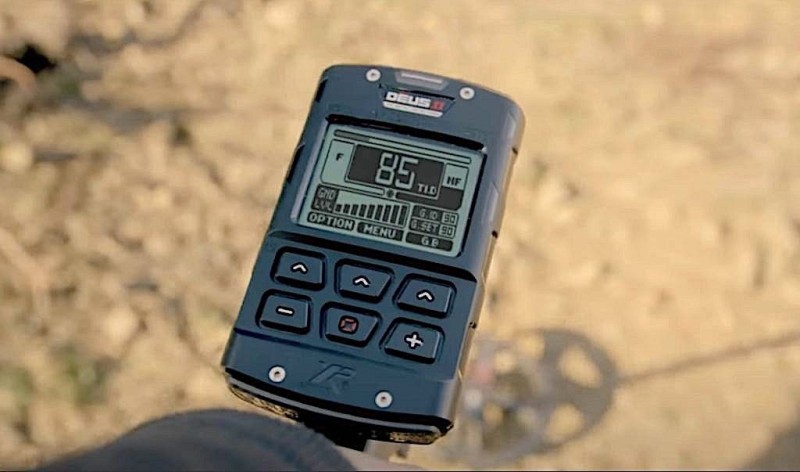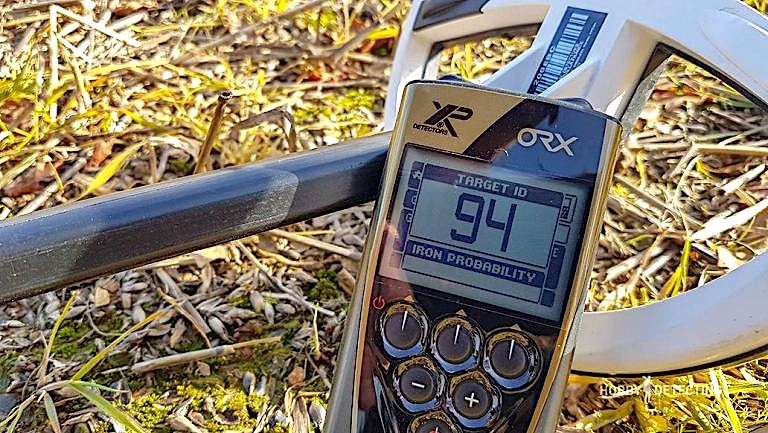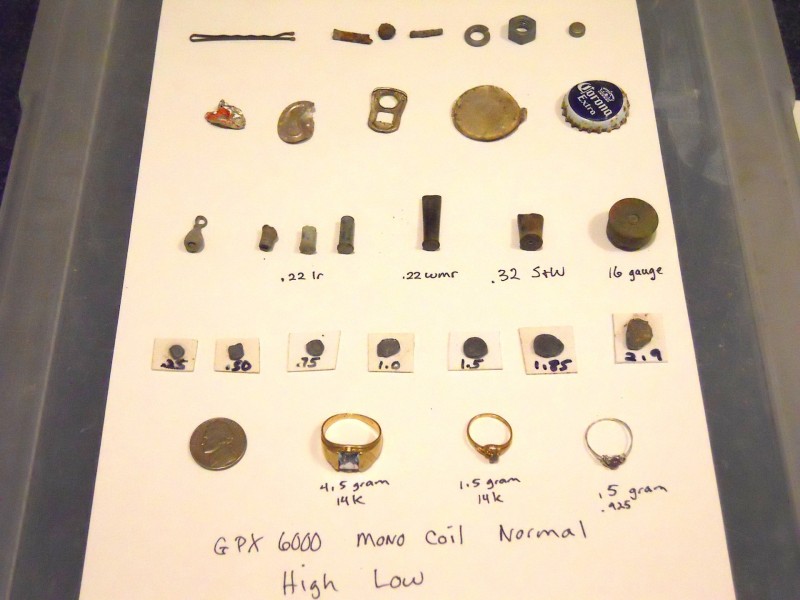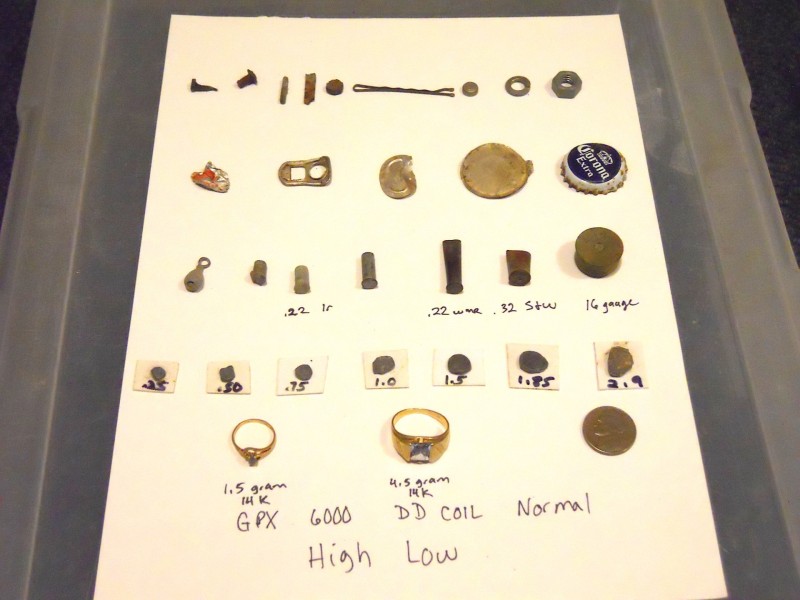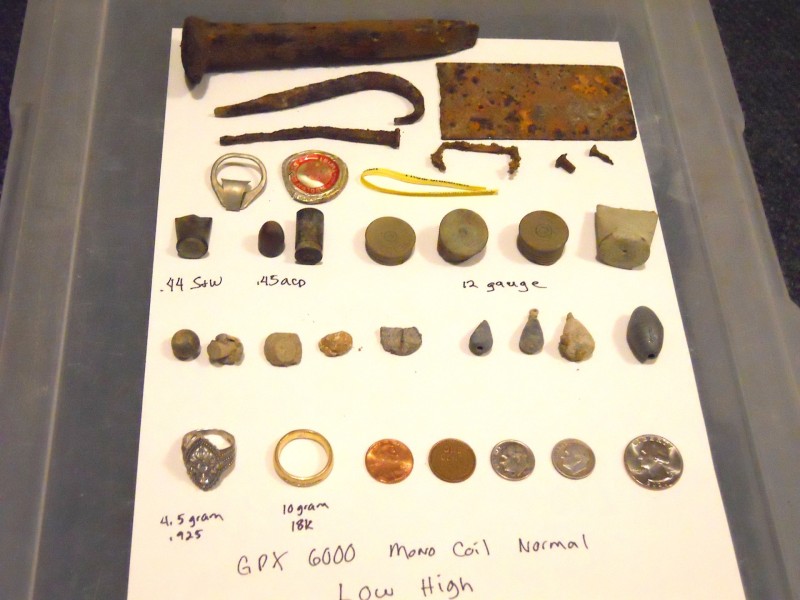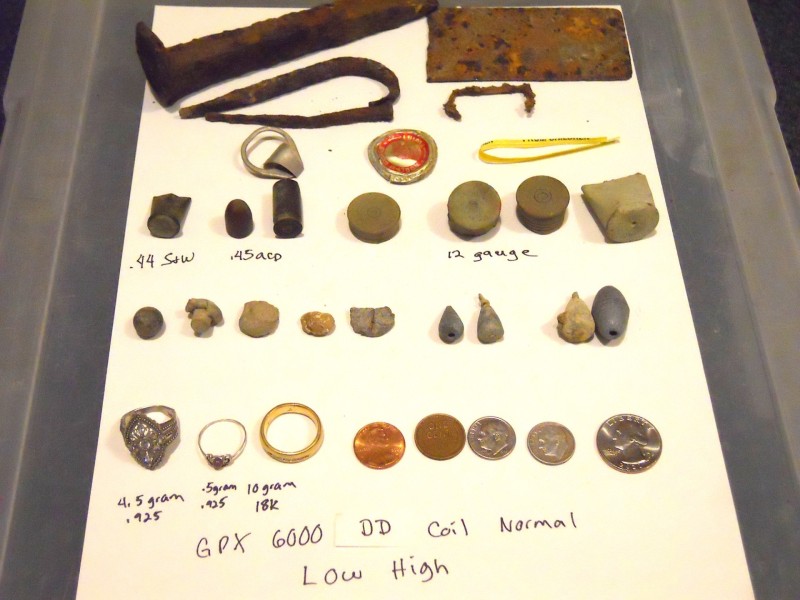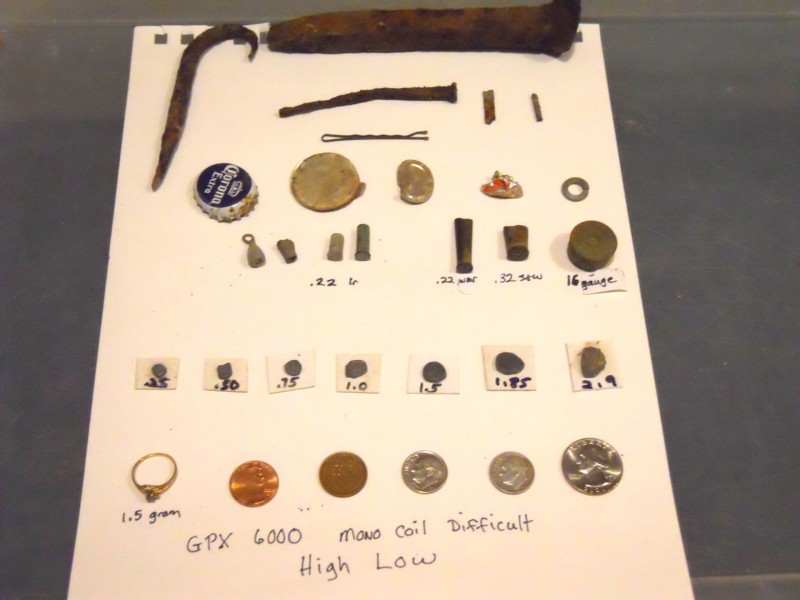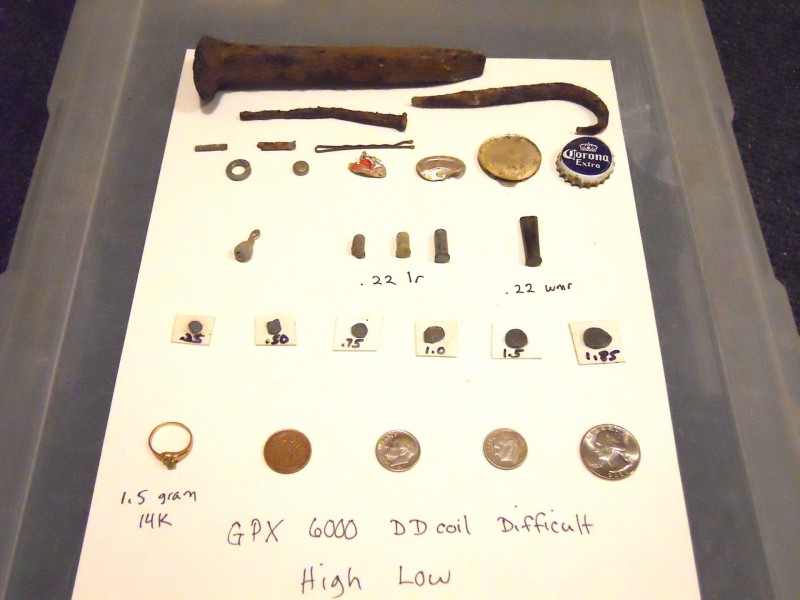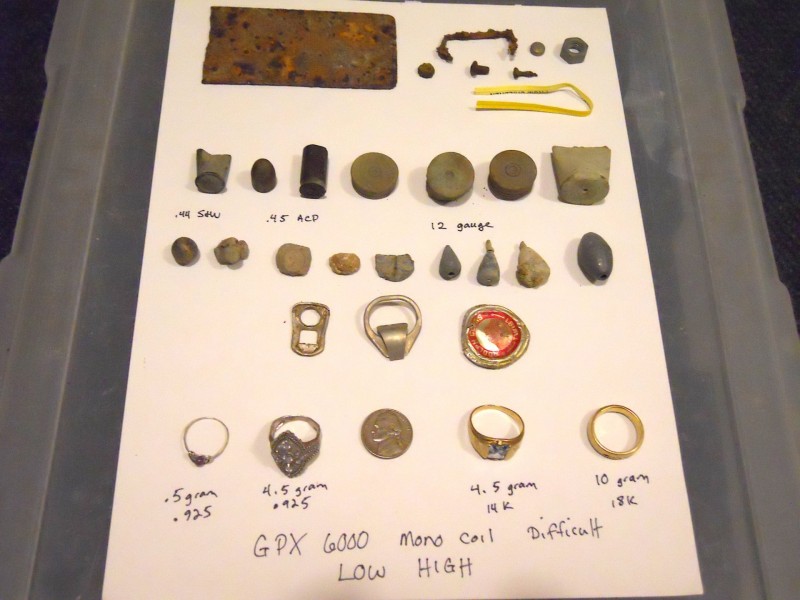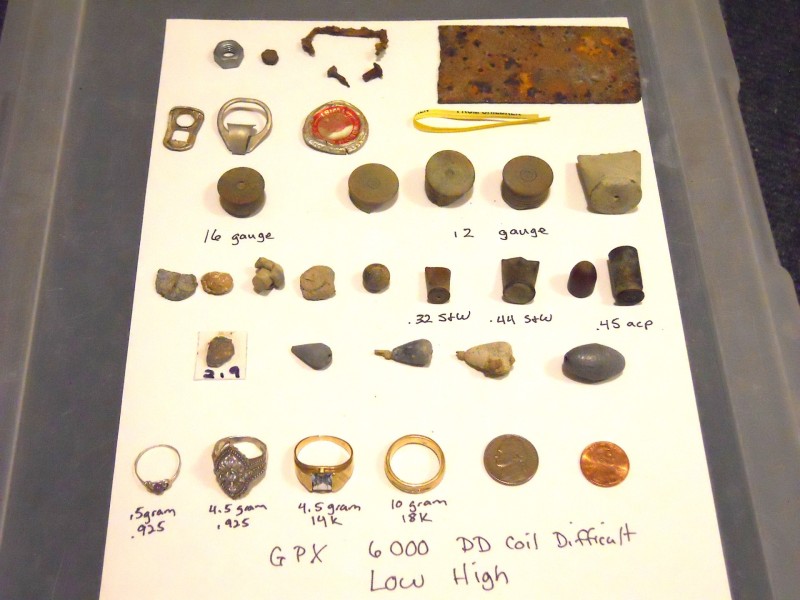-
Posts
3,176 -
Joined
-
Last visited
Content Type
Forums
Detector Prospector Home
Detector Database
Downloads
Everything posted by Jeff McClendon
-

So Can We Be Critical Of Deus II Here?
Jeff McClendon replied to Chase Goldman's topic in XP Deus II Forum
As someone that has used Deus 1 and the ORX, my thoughts are, I always had trouble seeing the Deus 1 target ID whether using the XY display, the horseshoe display or the other display which I can't remember too much about. I don't like the Deus 1's target ID's popup with the dark background and light numbers. No amount of adjusting the brightness or contrast helped. Deus 2 seems to have followed in Deus 1's footsteps. I wish Deus 2's design had instead copied something similar to the outstanding ORX popup target ID display with its light background and dark numbers along with its large size. -

So Can We Be Critical Of Deus II Here?
Jeff McClendon replied to Chase Goldman's topic in XP Deus II Forum
Chase, is there a 1/8" audio jack anywhere on the Deus 2 remote control or on the WS6. If not, I am assuming that the only way to plug external wired headphones into Deus 2 is via the horseshoe adapter that attaches to the WS6 controller or WSAll audio puck and is an accessory. Is that correct? There doesn't appear to be any other way to use 1/8" or 1/4" plug headphones unless XP is making an adapter cable that connects to the waterproof port on the back of the remote control. Just noticed in the manual that XP lists an audio jack cable that screws into the back of the remote control using the waterproof connector. It appears to be an accessory. -
The circuit board laying side ways directly opposite the battery is huge. Unless they can shrink it, fitting that board in an elliptical coil………..?
-

Conductive Soil Subtraction And Addition...what Is It?
Jeff McClendon replied to Jeff McClendon's topic in XP Deus II Forum
Hi Carl, I am not totally sure but the paragraph quoted above seems to refer to all of the FMF modes on Deus 2 not just the saltwater modes Deus 2 has manual salt sensitivity and iron sand settings adjustments on top of whatever CSS and CSA are........ The Equinox does all of that automatically in the background using its beach modes, especially Beach 2 from my understanding. -
I am still having some brain fog from Covid or maybe I am just old. This may have already been explained and I missed it. What are Conductive Soil Subtraction and Addition? Are these two happening automatically in the background using FMF or do they refer to picking the correct FMF program with their different frequency weighting for the soil conditions encountered. So basically is CSS/A done automatically or by user trial and error? This paragraph from the XP Deus ll FAQ section of the XP website does not clarify it for me. Maybe it is perfectly clear for some of you. DEUS II is unlike many other multifrequency detectors that usually offer multiple fixed frequencies, the DEUS II implements real combinations of different frequencies depending on the selected programs. For example, some will use low to medium frequencies (4 to 14kHz), and other programs will include higher frequencies up to 24kHz or 40kHz. To these combinations of frequencies specific signal processing is applied in order to best adapt to the terrain. These frequencies can be subtracted to remove electrically conductive soils or added to favour a wider range of targets if the soil is not too wet. So again, that last sentence refers to: subtracted or added by whom, the detector or me?
-
Toddy detects and grids a small Mediterranean volcanic/black sand beach with his new Deus 2. He has trouble ground balancing.......maybe he does not know how to use the Magnetic Ground-Beach part of the ground balance menu???? He uses Beach and Beach Sensitive anyway. There is some falsing during wave action and at the ends of swings that aren't level....but no real issues. Seems to work just fine. Extremely long, boring, lots of broken up signals on steel core European Union coins and a stainless steel ring from the wash at the end. He does switch to the external speaker after about 5 minutes. I speak English with a North Georgia accent and I'm Scotch Irish. Todd speaks English too but holy cow.......his Scotch English accent is off the charts.
-
You are asking very general questions about simultaneous multi frequency technology as if all SMF tech is the same. It definitely is not. Most SMF tech will help saltwater beach performance compared to a single frequency detector by being more stable and by making the salt mineralization more invisible than a single frequency detector. A few SMF detectors also have user adjustable or automatic black sand compensation which basically lowers the strength of the transmit signal so you can keep detecting. If iron mineralization away from the beach is the issue, most SMF tech up until the Equinox and Vanquish, did not perform very well and using a single frequency detector or a SMF detector made very little difference from my experience where I detect unless the targets where surface to 4" deep. Deeper than that and target ID was a 50/50 game of chance or much worse. The Equinox/Vanquish Multi IQ technology changed that by specifically concentrating on lessening the effect of iron signals created by ground mineralization which makes iron mineralization much more invisible compared to other detectors. Minelab's Multi IQ technology basically ignores much of the iron signals coming from the ground itself and all of the simultaneous multi frequencies in each mode concentrate on the multiple non-ferrous signals. So, making iron mineralized ground more invisible and concentrating on the non ferrous responses for obtaining a target ID helps the Equinox see deeper targets and if they are non-ferrous....helps to identify them more accurately. Making the ground more invisible also helps with target separation and masking since the Equinox at least, can be run hotter and have faster recovery speed than previous Minelab SMF technology since ground iron mineralization is less of a factor. The Equinox (not the Vanquish) will also ground balance very well even in more extreme iron mineralization with little loss of transmit strength compared to previous SMF and single frequency detectors. What form of technology is FMF in the Deus 2.............nothing definitive has been published by XP yet. Same for the technology in Nokta Makro's Legend. From the videos I have seen, both have very stable and accurate target IDs, are as deep as the Equinox using similar coils and both are a bit to a lot faster as far as recovery speed. Deus 1's speed and iron handling seem to have been transferred over to Deus 2 without missing a beat. I have not seen any testing of these detectors on ground or beaches that are highly iron mineralized however.
-

Relic Hunting With The GPX 6000?
Jeff McClendon replied to George Kinsey's topic in Detector Prospector Forum
That is basically the way I look at it too when prospecting for smaller gold. Depending on the site the inversion is somewhere between 2 and 5 grams. As long as I can hunt in Normal......avoiding big iron is not too hard to do if it is all over the site. If I have to hunt in Difficult so far anyway, it is basically dig it all with the 6000. -

Relic Hunting With The GPX 6000?
Jeff McClendon replied to George Kinsey's topic in Detector Prospector Forum
I have been experimenting with the GPX 6000 and relic/coin/jewelry hunting since it is too snowy and cold here to do much else and its fun. Basically, what I have found on wild digs and testing backs up what Steve H and Gerry have said already if one is using a Mono coil. The GPX 6000 with a Mono coil is incredible on tiny targets and will absolutely blow my head off for several seconds on larger targets. Using the 14" DD is a slightly different story however and that coil or other DD coils that might be aftermarket produced (PLEASE!!!!!) could make the GPX 6000 have even more relic/coin/jewelry possibilities due to less sensitivity and less elongated target responses. I have not by any means tested the GPX 6000 with a DD coil on enough mineralized sites to find out how much its automatic ground balance which can't be locked will change the low/high---high/low inversion point. So anything I say or show here is totally site specific to where I have been able to use it. My results show that usually (iron is always an oddball) the inversion point is between 4 and 5 grams weight or 2 and 3 grams weight depending on coil type, soil timing and ground balance. Here are some photos that it took me a while to find a pattern for so they are grouped like this: photos 1 and 2-Mono and DD (Cancel) coils using Normal with high/low target responses; photos 3 and 4-Mono and DD (Cancel) coils using Normal with low/high target responses; photos 5 and 6-Mono and DD(Cancel) coils using Difficult with high/low responses; and photos 7 and 8-Mono and DD(Cancel) coils using Difficult with low/high responses. Again, these are not definitive by any means. The sites tested are extremely iron mineralized to moderately iron mineralized. To me, these results show a clear advantage for the gold prospector if they want to identify big iron by using the GPX 6000 in Normal with either coil type, hunting by audio response (at least on my sites) and go for 5 or 3 gram and smaller gold. For a relic hunter, large caliber bullets and shell casing along with tiny iron and flat iron relics.....might be good using a DD in Difficult depending on trash levels at the site. The photos are basically organized from the top.....iron/steel, aluminum, brass/lead, coins/jewelry. Photo 1 Photo 2 Photo 3 Photo 4 Photo 5 Photo 6 Photo 7 Photo 8 -
#8 1 grain lead shot air tested on my 14" DD coil at 1" in Cancel/Normal. #9 .75 grain lead shot was touching the left edge of the 14" DD in Cancel/Normal. #8 1 grain lead shot air tested on my 11" mono coil at 1.5" in Normal. #9 .75 grain lead shot air tested on my 11" mono coil at .5" in Normal. Sensitivity was on 5 due to EMI. Results might be better on 10 or in Auto Plus (12) I don't have any #8 or #9 steel shot to test. Green, I also don't want to keep hijacking this VLF thread with PI GPX 6000 test results. Start a new thread if you want.
-

Nine Nokta/Makro Models Discontinued
Jeff McClendon replied to Steve Herschbach's topic in Nokta / Makro Metal Detectors
That is a great question. Maybe a Simplex, Kruzer or Anfibio owner can answer it for you Right now no one has a Legend in the US, even the field testers. -
I like all of the above plus target response inversion feature so that no matter what coil type is used and what setting...Mono, DD or Cancel it will be easy to make the low high/high low responses consistent and the inversion point predicatble. I personally have really been working with the GPX 6000 on this issue and it is driving me crazy..........
-
DD coils will also average two adjacent targets. Put a nail on top of or next to a US dime. In your scenario the Equinox will average the iron nail and non ferrous target when the center spine of the DD coil is parallel to the nail's orientation. With iron rejected the Equinox will more than likely null when the center spine of the DD coil is perpendicular to the nail's orientation. Depending on the detector's iron filtering quality, using a concentric coil in your scenario the targets will give a good response and be averaged (if you have a display), partially broken up but averaged or nulled. This is why most experienced relic hunters or hunters that detect in thick iron usually have all or most of the iron range target IDs accepted whether they are using a DD or concentric coil and why suspected borderline iron targets are approached from more than one direction when swinging a coil over them especially when using a DD coil.
-
Lead #8 and #9 birdshot is easily detected with the GPX 6000. I don’t own a 7000 so can’t speak about that. I also have no experience with modern #8 steel birdshot. My GPX 6000 will detect #8 lead birdshot with its DD coil too. So, .1 gram to .05 gram gold is no problem for the GPX 6000 or the Equinox 800 using its gold modes if it is within 2” to 3” of the surface.
-

Video Deus 2 Notch Feature Explained
Jeff McClendon replied to Jeff McClendon's topic in XP Deus II Forum
You could read the manual or just take my word for it. European coke seems to be detected by the Equinox using its multi frequency setting in the 0 to +2 target ID range. -
That’s the adapter. The WS6 with the back phones work really well and are really nice in hot weather since they don’t go over your ears and allow plenty of air flow. For me though, they are uncomfortable. I have a really big head however. Even most off the shelf sunglasses are uncomfortable and so are many headband headphones.
-
Gary Blackwell explains the Deus 2 Notch feature. Good news, the notch feature is on the WS 6 module too.... Bad new for gold prospectors and micro gold jewelry hunters, Sensitive, Sensitive FT and Fast have halo effect/coke notches by default at least on the version of software that Gary is using. Park also has the big 23-36 coke and tiny aluminum notch. So if gold prospecting/micro jewelry hunting with some of the 40 kHz discrimination programs, better remove that notch first. Dumbing down the Deus 2 for the masses like this is very similar to how Minelab dumbed down the Equinox with coke discrimination in Park 1, Field 1, Field 2 and making every program including the Gold modes have iron discriminated by default.
-
This is a fantastic topic. Since I usually use an Equinox in my area, I get lots of questions from fellow detector users about which mode to use..... This is just from my experience so it could be totally wrong. The frequency used in my detecting area which like KOB and Cal Cobra has soil that is definitely not inert, really matters in terms of what frequency can actually penetrate far enough to hit deeper targets. SMF tech like Multi IQ really helps but single frequency detectors in certain ranges work too. The rule of thumb would say a lower frequency would penetrate farther on say, coin sized US targets. That is just not the case here. Frequencies in the vicinity of 20 kHz or a bit higher seem to be able to get through the magnetic ground fog created by all of the magnetite and volcanics in the soil in my area. Detectors running below 12 kHz get absolutely no depth here. Even some approximately 13 kHz VLFs (MXT/MX7, T2 F75 are great examples) that ordinarily are incredibly deep don't do well at all here. So it seems to me that the amount and type of iron and volcanic content of the soil mineralization also determines what the best frequency/SMF frequencies may be for a certain area which may be determined by the size of the frequency wavelength. Using Multi IQ tech which seems to make the ground more invisible using the Equinox certainly helps here too.
-
Your choice of coin to test was totally fine. Not many people here in North America that metal detect would know what a .50 Euro coin is like. I just wanted to give people here a frame of reference.
-
Just for US/Canadian reference, the coin being used is a 50 cent Euro coin which is roughly the size of a Canadian Looney or a US Sacagewea $1 coin and weighs similarly.....7.8 grams, or a very big coin.
-

What's Wrong With The 3 Beach Programs???
Jeff McClendon replied to Skull diver's topic in XP Deus II Forum
The Deus 2 even in its FMF 14 kHz diving mode and with salt sensitivity settings above 0, will actually hit a .35 gram nugget in an air test in bad EMI. Not bad at all. Great depth....not particularly but air testing SMFs for depth is kind of pointless. In EMI like that, it is impossible to really get a good idea of what Deus 2 on a .35 gram nugget in Gold Field or its other 40 kHz programs without threshold/reactivity adjustments will do. Add in iron mineralization..........who knows. EMI just cuts high gain SMF tech detectors like the Deus 2 and Equinox off at the knees sometimes when it is really bad.- 12 replies
-
- xp deus 2
- beach detecting
-
(and 1 more)
Tagged with:
-

What's Wrong With The 3 Beach Programs???
Jeff McClendon replied to Skull diver's topic in XP Deus II Forum
NOTHING is wrong with the Beach modes......... First, the ground was moderately mineralized from looking at the mineralization meter in the lower left of the screen. Second the gentleman was swinging fairly haphazardly with lots of arc on the end of each swing and he often almost missed the targets. So, there is nothing wrong with the Beach programs that I can see. 10. Diving is maxed at 14 kHz, so not the best frequency for small gold under 1 gram depending on shape. This by the way, is where at least on paper, the Excal maxed at 26 kHz has the advantage on Deus 2 and its 14 kHz Diving program. Otherwise.......Deus 2 all day for most gold jewelry using Beach or Beach Sensitive. 11. Beach is maxed at 24 kHz. Definitely more sensitive than Diving at 14 kHz but still won't hit hard on sub gram sized gold. 12. Beach Sensitive is maxed at 40kHz. That will hit most small gold jewelry from 1 gram down to .1 gram that is near the surface and will scream on 1 gram and up gold jewelry. The other modes 1. Gen, 2. Sens, 3. Sens FT, 4. Fast, 8. Gold are all maxed at 40 kHz and will have no problem on .1 and bigger gold jewelry. Only the Gold mode hit that .05 piece really well.....VCO audio helped there. 9. Relic is maxed at 24 kHz which is okay. It will scream on small gold coins or 1 gram and up jewelry at relic sites. 5. Park is maxed at 24 kHz plus it has a default notch from 23 to 36.....right in the small gold range along with Bottle Cap reject set at 5 which may also mask small gold targets. So, default Park for small gold jewelry is highly iffy unless some settings are changed. 6. Deep High Conductor is maxed at 14 kHz.....not for gold basically 7. Deus Mono default at 17 kHz. Not the greatest small gold frequency. Deus Mono is not using XP's FMF technology. It is a throwback, holdover from Deus 1. Target IDs may up or down average a bit depending on selected frequency, on target size, conductivity and the level of ground mineralization. I will not be using that mode very much...... So, in my opinion the Deus 2 in its default settings performed about as expected on different sized gold targets laying on mineralized ground. For the modes that are optimized for gold (40kHz), the target IDs were consistent and so were the audio responses for each target.- 12 replies
-
- xp deus 2
- beach detecting
-
(and 1 more)
Tagged with:


